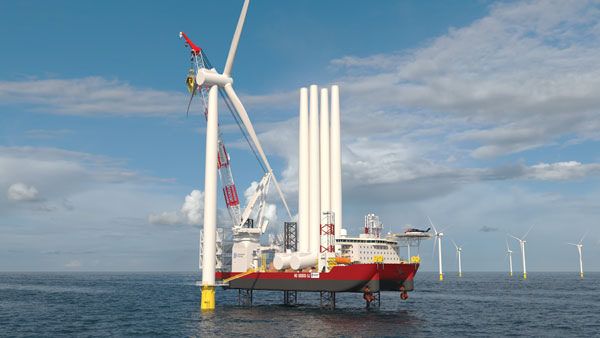Amid the headwinds confronting the Biden administration’s ambitious goals for offshore wind energy, Dominion Energy’s Coastal Virginia Offshore Wind project continues to move forward. The largest such project of its kind, CVOW is expected to produce 2.6 gigawatts of electricity, a sizable chunk of the administration’s goal of 30 gigawatts by 2030.
In May, Dominion began installing foundations — known as monopiles — that will support 176 Siemens Gamesa wind turbines, each projected to produce 14 megawatts of energy from a wind field some 27 miles off the coast of Hampton Roads. That development followed the launch from Brownsville, Texas, of a costly and complex installation vessel whose eventual deployment is viewed as a major advancement.
Through a byzantine set of circumstances, these two recent successes are closely related. The World War I-era Jones Act, a protectionist measure crafted to bolster domestic shipbuilding, mandates that goods shipped between domestic “points” be transported on ships that are built, owned and operated in the United States. Each monopile laid by Dominion creates such a point, its companion point being the port from which said vessel is launched. Named for a sea monster from Greek mythology, Dominion’s newly launched Charybdis aimed to be the nation’s first Jones Act-compliant vessel for installing offshore turbines (though Edison Chouest’s ECO Edison servicing the Ørsted Revolution Wind project off Rhode Island arrived there in June). The Charybdis cost $625 million to construct — more than $100 million higher than originally projected.
Early on during a two-turbine, offshore pilot project, Dominion managed to end-run the Jones Act by utilizing ports in Canada as staging grounds for components shipped from Europe. An installation vessel made repeated trips from Nova Scotia to the offshore construction zone to install foundations and then the remaining turbine parts.
“It worked for the two pilot turbines,” says Dominion spokesman Jeremy Slayton, “but for 176, that does not work.” Still, the company learned much through the roundabout pilot process.
“It’s when we really decided that, look, there just aren’t a lot of vessels that can do the installation and we can create this reliable, homegrown installation solution with the capacity to handle the next generation of large-scale, highly efficient turbines. And that’s what we’re doing by building the Charybdis.” The company is holding talks to later lease the vessel for other offshore wind ventures.
With a projected deployment late this year or early next, the Charybdis represents momentum in a challenging environment. Ørsted last year canceled its Ocean Wind projects off New Jersey’s coast and pulled out of an agreement with Maryland in order to negotiate better terms for its Skipjack projects off the Maryland coastline near Ocean City. What, then, is Dominion doing right that others aren’t?
“What really separates our project from the other ones is we are both the electric utility and we’re building the project,” says Slayton. As such, he says, Dominion went through a lengthy approvals process with Virginia state regulators, whose financial audit required various supply chain and manufacturing contracts to be entered into up front. That, says Slayton, gave Dominion what turned out to be a fortuitous head start.
“We had those contracts done,” Slayton says, “before interest rates went up and before all these supply chain issues arose. Our costs were already locked in, and so we haven’t been as impacted to the same extent as those other projects that weren’t.”

